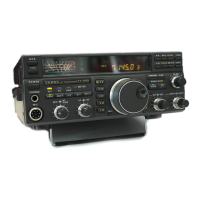Operation
Memory
Features
beep sounds (to overwrite the current memory
with the retuned data). The labelling of the
VFO
-
M
button is somewhat deceptive here: the VFO
settings, which are hidden at this point, are not
involved in this operation at all, since those of
the recalled memory have taken their place.
As mentioned above, if you just want to can-
cel any changes you have made to a recalled
I
memory, press
VFOlM
once
("MEM"
is displayed
I
I
again), and press it again if you want to return to
!
the VFOs. The display mode changes are sum-
marized at the top of the previous page.
Split operation can be enabled and stored in a
memory, in which case the rear half of the mem-
ory is used for transmission. Similarly, pressing
the
A/B
button while receiving on a memory
switches operation between the front and rear
halves of the memory (don't forget both of these
functions also activate memory tuning).
Memory Scanning
When receiving on a recalled memory (with
"MEM"
displayed), you can scan the front halves
of all stored memories. ust hold the microphone
1
DWN
or
UP
button for
/2
second to start. If you
want scanning to pause on signals, you must
first adjust the
SQL
control to silence the receiver
(BUSY
LED
right of the meter off) on a clear
channel. Scanning pauses on any channel having
a signal strong enough to open the squelch, and
the two decimal points in the frequency display
blink. By default, scanning resumes only after
the signal disappears. Alternatively, you can also
have scanning resume automatically after
5
sec-
onds. To toggle these scan-resume modes, turn
off the transceiver and turn it on again while
holding the
VFOIM
button.
You may need to readjust the
SQL
control to
prevent scanning from stopping on only back-
ground noise.
To stop scanning press the
PTT
switch (no
transmission will occur), or a microphone button
again. When scanning, keep in mind that the
IPO
and
ATT
buttons and
RF
gain setting also affect
the squelch threshold.
Memory
Scan
Skip
Once you have stored many memories, you
probably won't want to scan every one of them.
You can mark some of them to be skipped during
scanning. To do this, recall the memory to be
skipped, and hold the
FAST
button below the left
side of the tuning knob (or on the microphone)
while pressing
VFOIM
momentarily.
"SKIP"
ap-
pears above the memory number at the right.
If you have set a memory to be skipped, and
later want to include it, just repeat the
FAST
+
VFOIM
procedure.
Memory Blanking
After storing many memories, you may want
to completely hide some from normal operation,
to simplify selection of the others. To blank a
displayed memory, while
"MEM"
is displayed at
the left of the frequency, press and hold the yel-
low-labelled
VFO-M
button for %-second until
the double beep sounds. But be careful: if you do
this instead while
"M
TUNE"
is displayed
-
that
is,
after retuning the memory, the retuned data
will overwrite the original memory data, but it
will not be blanked. So, if you have retuned the
memory and don't want to save the changes,
cancel them first by
pressin
VFOIM
once, and
5
then hold
VFO*M
button for h-second.
While a memory is blanked, no frequency
digits appear, and
"CLEAR"
appears above the
memory number at the right end of the display.
As long as you don't overwrite a blanked
memory, you can unblank it simply by repeating
the same procedure you used to blank it.
Band
b
Subband Scanning:
Subband Limit Memories
PI
&
P2
As you have probably already discovered,
when operating on a VFO or retuned memory,
holding either the
DWN
or
UP
button on the mi-
crophone for
'/2
second starts scanning, and
pressing one of these buttons again stops it. By
setting the
SQL
control so that the receiver is just
silenced on a clear frequency, scanning will
pause when it finds a signal, and resume accord-
ing to the scan-resume selection described above
under Memory
Scanning.
You can also increase the scanning step size by
10, by pressing the
FAST
button while scanning
(or toggling it on, if you have set it to work that
way
-
see page
12).
If you let scanning continue indefinitely, it
will loop around when it reaches
0
or
30
MHz,
including the entire range of receiver coverage.
To limit scanning to a particular frequency
range, you will want to make use of the pro-
grammable scanning limit (we call it
PMS) facil-
ity provided with memories
P1 and
P2.
page
25

